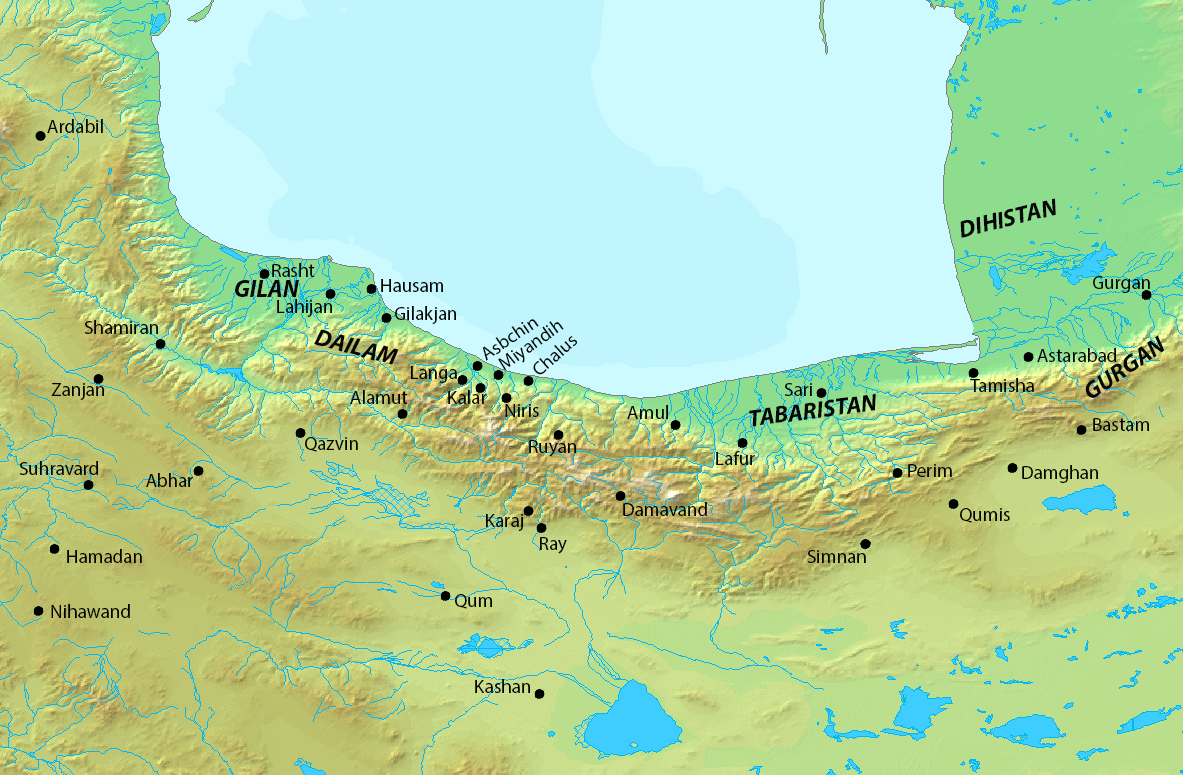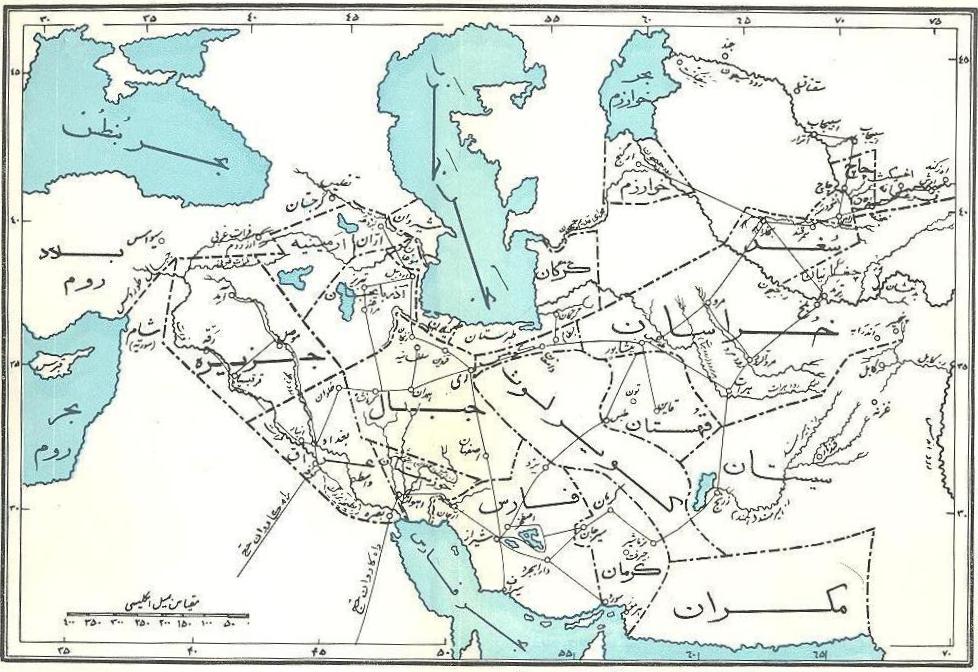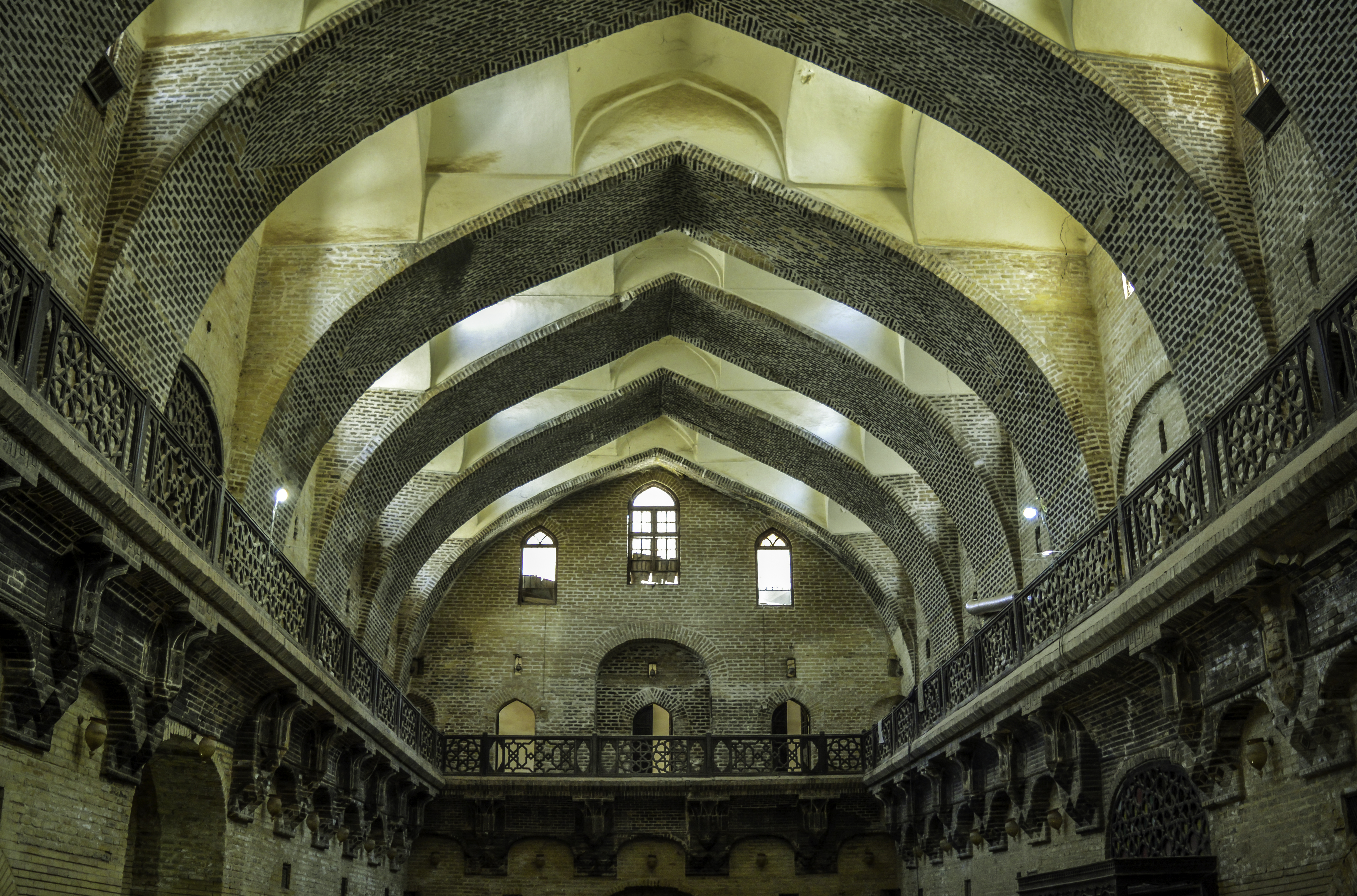|
'Adud Al-Dawla
Fannā (Panāh) Khusraw (), better known by his laqab of ʿAḍud al-Dawla (; 24 September 936 – 26 March 983) was an emir of the Buyid dynasty, ruling from 949 to 983. At the height of his power, he ruled an empire stretching from Makran to Yemen and the shores of the Mediterranean Sea. He is widely regarded as the greatest monarch of the Buyid dynasty, and by the end of his reign he was the most powerful ruler in the Middle East. Early life Fanna Khusraw was born in Isfahan on 24 September 936. He was the son of Rukn al-Dawla, the brother of Imad al-Dawla and Mu'izz al-Dawla. According to Ibn Isfandiyar, Fanna Khusraw's mother was the daughter of the Daylamites, Daylamite Firuzanids, Firuzanid nobleman al-Hasan ibn al-Fairuzan, who was the cousin of the prominent Daylamite military leader Makan ibn Kaki. In 948, Fanna Khusraw was chosen by his uncle Imad al-Dawla as his successor because he had no heir. Imad al-Dawla died in December 949, and thus Fanna Khusraw became th ... [...More Info...] [...Related Items...] OR: [Wikipedia] [Google] [Baidu] |
Amir Al-Umara
The office of (), variously rendered in English as emir of emirs, prince of princes, chief emir, and commander of commanders, was a senior military position in the 10th-century Abbasid Caliphate, whose holders in the decade after 936 came to supersede the civilian bureaucracy under the vizier and become effective regents, relegating the Abbasid caliphs to a purely ceremonial role. The office then formed the basis for the Buyid dynasty, Buyid control over the Abbasid caliphs and over Iraq until the mid-11th century. The title continued in use by Muslim states in the Middle East, but was mostly restricted to senior military leaders. It was also used in Norman Sicily for a few of the king's chief ministers. In the Abbasid Caliphate Background The first person to be titled was the commander Harun ibn Gharib, a cousin of the Caliph al-Muqtadir (), in 928. He was followed soon after by his rival, the eunuch Mu'nis al-Muzaffar (845–933), who served as commander-in-chief of the cal ... [...More Info...] [...Related Items...] OR: [Wikipedia] [Google] [Baidu] |
Rukn Al-Dawla
Hasan (died September 976), better known by his ''laqab'' as Rukn al-Dawla ( Persian: رکنالدوله دیلمی), was the first Buyid amir of northern and central Iran (c. 935–976). He was the son of Buya. Struggle for power Hasan was the son of Buya, a Dailamite fisherman from Lahijan, who left his Zoroastrian faith and converted to Islam. Hasan had an older brother named 'Ali and a younger brother named Ahmad. He also had a sister named Kama. In around 928, Hasan's brother 'Ali joined the services of Makan, who was the Samanid governor of Ray. 'Ali then managed to gain military positions for Hasan and their other brother Ahmad. At the time, Hasan was about thirty years old. When Makan attacked his Samanid overlords and was subsequently defeated by the Ziyarid prince Mardavij, the brothers transferred their allegiance to the latter. In the following years, 'Ali repudiated his subservience to Mardavij and, after some time, managed to create an empire in Fars. Du ... [...More Info...] [...Related Items...] OR: [Wikipedia] [Google] [Baidu] |
Middle East
The Middle East (term originally coined in English language) is a geopolitical region encompassing the Arabian Peninsula, the Levant, Turkey, Egypt, Iran, and Iraq. The term came into widespread usage by the United Kingdom and western European nations in the early 20th century as a replacement of the term Near East (both were in contrast to the Far East). The term "Middle East" has led to some confusion over its changing definitions. Since the late 20th century, it has been criticized as being too Eurocentrism, Eurocentric. The region includes the vast majority of the territories included in the closely associated definition of West Asia, but without the South Caucasus. It also includes all of Egypt (not just the Sinai Peninsula, Sinai) and all of Turkey (including East Thrace). Most Middle Eastern countries (13 out of 18) are part of the Arab world. The list of Middle Eastern countries by population, most populous countries in the region are Egypt, Turkey, and Iran, whil ... [...More Info...] [...Related Items...] OR: [Wikipedia] [Google] [Baidu] |
Mediterranean Sea
The Mediterranean Sea ( ) is a sea connected to the Atlantic Ocean, surrounded by the Mediterranean basin and almost completely enclosed by land: on the east by the Levant in West Asia, on the north by Anatolia in West Asia and Southern Europe, on the south by North Africa, and on the west almost by the Morocco–Spain border. The Mediterranean Sea covers an area of about , representing 0.7% of the global ocean surface, but its connection to the Atlantic via the Strait of Gibraltar—the narrow strait that connects the Atlantic Ocean to the Mediterranean Sea and separates the Iberian Peninsula in Europe from Morocco in Africa—is only wide. Geological evidence indicates that around 5.9 million years ago, the Mediterranean was cut off from the Atlantic and was partly or completely desiccation, desiccated over a period of some 600,000 years during the Messinian salinity crisis before being refilled by the Zanclean flood about 5.3 million years ago. The sea was an important ... [...More Info...] [...Related Items...] OR: [Wikipedia] [Google] [Baidu] |
Yemen
Yemen, officially the Republic of Yemen, is a country in West Asia. Located in South Arabia, southern Arabia, it borders Saudi Arabia to Saudi Arabia–Yemen border, the north, Oman to Oman–Yemen border, the northeast, the south-eastern part of the Arabian Sea to the east, the Gulf of Aden to the south, and the Red Sea to the west, sharing maritime boundary, maritime borders with Djibouti, Eritrea, and Somalia across the Horn of Africa. Covering roughly 455,503 square kilometres (175,871 square miles), with a coastline of approximately , Yemen is the second largest country on the Arabian Peninsula. Sanaa is its constitutional capital and largest city. Yemen's estimated population is 34.7 million, mostly Arabs, Arab Muslims. It is a member of the Arab League, the United Nations, the Non-Aligned Movement and the Organisation of Islamic Cooperation. Owing to its geographic location, Yemen has been at the crossroads of many civilisations for over 7,000 years. In 1200 BCE, the Sab ... [...More Info...] [...Related Items...] OR: [Wikipedia] [Google] [Baidu] |
Makran
Makran (), also mentioned in some sources as ''Mecran'' and ''Mokrān'', is the southern coastal region of Balochistan. It is a semi-desert coastal strip in the Balochistan province in Pakistan and in Iran, along the coast of the Gulf of Oman. It extends westwards, from the Sonmiani Bay to the northwest of Karachi in the east, to the fringes of the region of Bashkardia/Bāšgerd in the southern part of the Sistan and Baluchestan province of modern Iran. Makrān is thus bisected by the modern political boundary between Pakistan and Iran. In January 2025, a government spokesperson informed that Iran is investigating the possibility of moving its capital to the Makran region. Etymology The southern part of Balochistan is called ''Kech Makran'' on the Pakistani side and Makran on the Iranian side which is also the name of a former Iranian province. The location corresponds to that of the Maka satrapy in Achaemenid times. The Sumerian trading partners of Magan are identified wit ... [...More Info...] [...Related Items...] OR: [Wikipedia] [Google] [Baidu] |
Emir
Emir (; ' (), also Romanization of Arabic, transliterated as amir, is a word of Arabic language, Arabic origin that can refer to a male monarch, aristocratic, aristocrat, holder of high-ranking military or political office, or other person possessing actual or ceremonial authority. The title has a history of use in West Asia, East Africa, West Africa, Central Asia, and South Asia. In the modern era, when used as a formal monarchical title, it is roughly synonymous with "prince", applicable both to a son of a hereditary monarch, and to a reigning monarch of a sovereign principality, namely an emirate. The female, feminine form is emira ( '), with the same meaning as "princess". Prior to its use as a monarchical title, the term "emir" was historically used to denote a "commander", "general", or "leader" (for example, Amir al-Mu'min). In contemporary usage, "emir" is also sometimes used as either an honorary or formal title for the head of an Islamic, or Arab (regardless of relig ... [...More Info...] [...Related Items...] OR: [Wikipedia] [Google] [Baidu] |
Laqab
Arabic names have historically been based on a long naming system. Many people from Arabic-speaking and also non-Arab Muslim countries have not had given name, given, middle name, middle, and family names but rather a chain of names. This system remains in use throughout the Arab world, Arab and Muslim world, Muslim worlds. Name structure ' The ' () is the given name, first name, or personal name; e.g. "Ahmad" or "Fatima (given name), Fatima". Most Arabic names have meaning as ordinary adjectives and nouns, and are often aspirational of character. For example, ''Muhammad (name), Muhammad'' means 'Praiseworthy' and ''Ali (name), Ali'' means 'Exalted' or 'High'. The syntactic context will generally differentiate the name from the noun or adjective. However, Arabic newspapers will occasionally place names in brackets, or quotation marks, to avoid confusion. In fact, the name ''Muhammad'' is so popular throughout parts of Africa, Arabia, the Middle East, South Asia and Southeast As ... [...More Info...] [...Related Items...] OR: [Wikipedia] [Google] [Baidu] |
Shia Islam
Shia Islam is the second-largest Islamic schools and branches, branch of Islam. It holds that Muhammad in Islam, Muhammad designated Ali ibn Abi Talib () as both his political Succession to Muhammad, successor (caliph) and as the spiritual leader of the Muslim community (Imamah (Shia doctrine), imam). However, his right is understood to have been usurped by a number of Companions of the Prophet, Muhammad's companions at the meeting of Saqifa where they appointed Abu Bakr () as caliph instead. As such, Sunni Muslims believe Abu Bakr, Umar (), Uthman () and Ali to be 'Rashidun, rightly-guided caliphs' whereas Shia Muslims only regard Ali as the legitimate successor. Shia Muslims assert imamate continued through Ali's sons Hasan ibn Ali, Hasan and Husayn ibn Ali, Husayn, after whom different Shia branches have their own imams. They revere the , the family of Muhammad, maintaining that they possess divine knowledge. Shia holy sites include the Imam Ali Shrine, shrine of Ali in Naj ... [...More Info...] [...Related Items...] OR: [Wikipedia] [Google] [Baidu] |
Najaf
Najaf is the capital city of the Najaf Governorate in central Iraq, about 160 km (99 mi) south of Baghdad. Its estimated population in 2024 is about 1.41 million people. It is widely considered amongst the holiest cities of Shia Islam and one of its spiritual capitals, as well as the center of Shia political power in Iraq. It is the Imam Ali Shrine, burial place of Muhammad's son in law and cousin, ‘Alī ibn Abī Tālib, and thus a major pilgrimage destination for Shia Muslims. The largest cemetery in the world (Wadi-us-Salaam) and the oldest Shi'a Islamic seminary in the world (Hawza Najaf, Hawza of Najaf) are located in Najaf. Etymology According to Ibn Manzur, the word, "najaf" (), literally means a high and rectangular place around which water is accumulated, although the water does not go above its level. Al-Shaykh al-Saduq appeals to a hadith from Ja'far al-Sadiq, claiming that "Najaf" comes from the phrase, "nay jaff" which means "the nay sea has dried". "Naj ... [...More Info...] [...Related Items...] OR: [Wikipedia] [Google] [Baidu] |
Abbasid Caliphate
The Abbasid Caliphate or Abbasid Empire (; ) was the third caliphate to succeed the Islamic prophet Muhammad. It was founded by a dynasty descended from Muhammad's uncle, Abbas ibn Abd al-Muttalib (566–653 CE), from whom the dynasty takes its name. After overthrowing the Umayyad Caliphate in the Abbasid Revolution of 750 CE (132 AH), they ruled as caliphs based in modern-day Iraq, with Baghdad being their capital for most of their history. The Abbasid Revolution had its origins and first successes in the easterly region of Khurasan, far from the Levantine center of Umayyad influence. The Abbasid Caliphate first centered its government in Kufa, modern-day Iraq, but in 762 the caliph al-Mansur founded the city of Baghdad as the new capital. Baghdad became the center of science, culture, arts, and invention in what became known as the Golden Age of Islam. By housing several key academic institutions, including the House of Wisdom, as well as a multiethnic and multi- ... [...More Info...] [...Related Items...] OR: [Wikipedia] [Google] [Baidu] |
Baghdad
Baghdad ( or ; , ) is the capital and List of largest cities of Iraq, largest city of Iraq, located along the Tigris in the central part of the country. With a population exceeding 7 million, it ranks among the List of largest cities in the Arab world, most populous cities in the Middle East and Arab world and forms 22% of the Demographics of Iraq, country's population. Spanning an area of approximately , Baghdad is the capital of its Baghdad Governorate, governorate and serves as Iraq's political, economic, and cultural hub. Founded in 762 AD by Al-Mansur, Baghdad was the capital of the Abbasid Caliphate and became its most notable development project. The city evolved into a cultural and intellectual center of the Muslim world. This, in addition to housing several key academic institutions, including the House of Wisdom, as well as a multi-ethnic and multi-religious environment, garnered it a worldwide reputation as the "Center of Learning". For much of the Abbasid era, duri ... [...More Info...] [...Related Items...] OR: [Wikipedia] [Google] [Baidu] |











